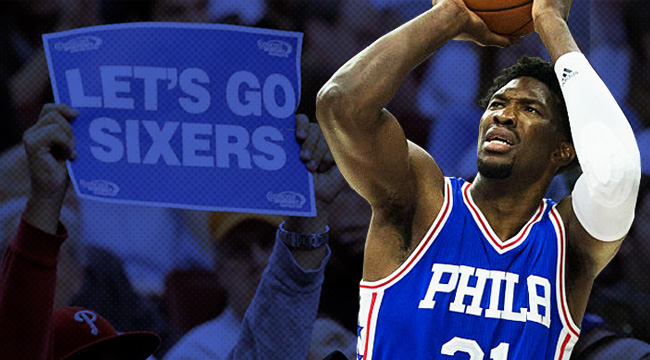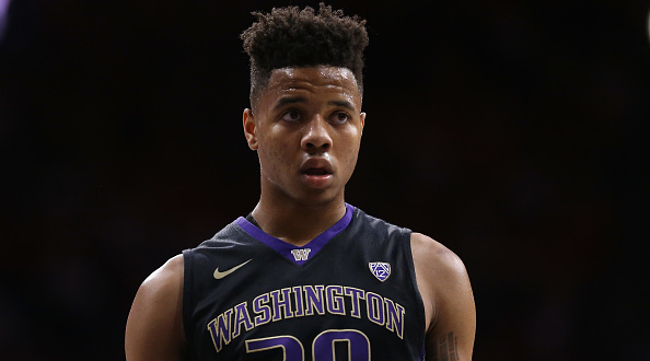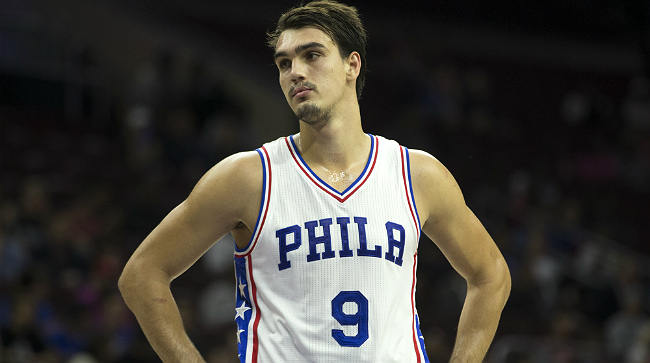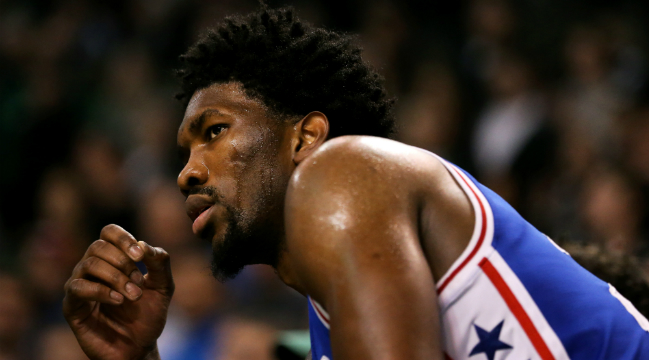
PHILADELPHIA — Joel Embiid calmly stepped up to the free throw line. For a big man, he’s a really good free throw shooter — he connected on 78.3 percent of his attempts from the charity stripe during his rookie campaign, which was seventh-best among centers on the year.
He was just fouled by Nene, and drilling his first attempt while being serenaded with “Trust The Process” chants, something happens. Embiid steps away from the free throw line and begins walking towards half court, his arm flying in the air to signify that, if anything, the already raucous crowd in Philaelphia is not being loud enough.
In a way, it’s like watching a conductor lead an orchestra. Embiid’s magnetic personality had drawn in Sixers fans from the day he was drafted, and once he finally saw the floor after two years of rehabilitating foot injuries and showed he could back up his general silliness with his game, it was over. He was suddenly a star, the kind of player Sixers fans had badly wanted since a man defined by his initials was crossing people over and leaving a trail of broken angles in his wake.
“It’s insane man,” said Valentin, my Uber driver on the ride over to the game. “It reminds me of when Allen Iverson used to play. You want to go to the game.”
“He knows we’re hungry,” Valentin added. “He knows it.”
It’s fascinating to watch. Embiid is in his early-20s, seriously took up basketball when he was 15, and came to America a year later. Fast forward a few years and he is sort of the manifestation the hopes and dreams of one of basketball’s most historic franchises 31 games into his professional career.
Embiid, a 23-year-old native of Cameroon, is proof that crazy things happen when you trust the process.

This game — a 123-118 loss to Houston on Jan. 27 in which James Harden painted his masterpiece during what could end up being an MVP campaign (a 51-point triple-double, which was breathtaking to watch in person) — ended up being Embiid’s final one of the year. He suffered a knee injury on Jan. 20, missed the next three games, put up 32 points and pulled down seven rebounds in 28 minutes against Houston, and then got shut down for the remainder of the season with a torn meniscus in his left knee.
He probably shouldn’t have played against the Rockets, but this was a big game. The much-anticipated Harden-Embiid showdown was flexed into a primetime spot on ESPN, which was something of unfamiliar territory for Sixers fans. Well, at least in the context of the team’s recent history.
For the last three years, the team had been stuck in a grueling stretch of awfulness. From 2013-16, Philly’s record was 47-199. The 2016-17 campaign, which saw the team go 28-54, was the first time the team won more than 19 games since 2013-14. In a sport where you are supposed to win as many games as possible, Philadelphia took a slightly different approach that became lovingly (or, depending on who you ask, sarcastically) known as “The Process.”
“I guess it was this idea from the get go of having just like a plan,” said Michael Levin, a co-host of the Sixers podcast Rights to Ricky Sanchez. “The Sixers for a long time didn’t have one at all, and it was just signing second, third, fourth tier, somewhat decent players to play with Iverson and hoping that it just clicked. Then that sort of ran its course and then it was just signing aimless guys to play for Doug Collins or whoever was coaching at the time and having no real vision for what the team would look like in 3-5 years or a road to legitimate contention.”
To a skeptic, The Process was an abomination. There’s a video of ESPN’s Stephen A. Smith, who covered the team for more than a decade, telling people who embraced the phrase “Trust The Process” to go to hell. The argument against it was that the team was empowered to lose, that they were trying to be bad rather than trying to be good. With how teams are expected to try and compete for championships every year, Philadelphia’s lengthy stretch of self-inflicted cellar dwelling with the hopes that it may pay off down the road was as stunning as it was polarizing.
To a number Sixers fans, though, it was a ray of hope. It was a way for the team to break the cycle of mediocrity it was stuck in with the hopes that a championship could be on the horizon. That 47-199 stretch was brutal, but before it, there was a stretch of 12 years where the team finished better than 43-39 once. After making the NBA Finals in 2001, Philly made the postseason seven times in the next 12 years and advanced out of the first round twice.
If you were to look for a mediocre basketball franchise, you’d end up in Philadelphia. The Process was an attempt to buck this trend, a “the night is darkest before the dawn” approach to putting together a roster. It also asked a usually hypothetical question that is sometimes posed to fans: Would you rather be ok and never be in a position to win a championship, or suck for a few years and hope it pays off?
Depending on who you ask, the whole thing informally started on June 27, 2013. On Thursday, The Process will see one of its biggest wins yet, when after trading for the No. 1 pick in the NBA Draft, the Sixers select Washington guard Markelle Fultz, who joins a core that could potentially be among the league’s best if everything goes right.

The four core players on the Sixers are Embiid, Dario Saric, Ben Simmons, and (once he’s drafted), Fultz. Two of them joined the team through fairly normal circumstances: Embiid was selected with the No. 3 pick in the 2014 NBA Draft, Simmons was drafted two years later with the top selection. Sure, you can argue both players joined the team because of Embiid’s foot injury. It reportedly scared off teams at the top of the 2014 Draft, and due to the face he had to sit out for two years, the Sixers lost enough games to put themselves in a position for Simmons.
But Saric and Fultz, more than anyone else, showed off Philadelphia’s desire to wheel and deal in an attempt to get young, talented players in ways that could be unconventional. The wheels were put in motion for Saric on June 27, 2013. Ostensibly, Saric was considered a consolation in the deal, which sent All-Star guard Jrue Holiday to New Orleans. In exchange, the Sixers acquired Nerlens Noel and a 2014 first-round pick. The centerpiece of the deal was supposed to be Noel, who is no longer with the team.
That first-round pick landed at No. 10. Philadelphia picked Louisiana-Lafayette guard Elfrid Payton, then flipped him to Orlando for Saric — who the Magic took at No. 12 — a second-round pick in 2015, and a future first-rounder. While Saric played in the Euroleague for two years before coming over this past season, it’s very possible that Philadelphia won this trade, as Saric is a Rookie of the Year candidate while Payton’s time in Orlando has been up and down.
The path that led to Fultz coming to Philadelphia is even more bizarre. A trio of trades eventually led to what seems like a foregone conclusion on Thursday night, starting with the deal that shipped Michael Carter-Williams out of town on Feb. 19, 2015.
At the time, it seemed absurd. Carter-Williams was a former Rookie of the Year and the team’s best player. He was moved in a deal that netted Philadelphia a future first-round pick that belonged to the Los Angeles Lakers. Despite that looking like it could be a good pick with how bleak Los Angeles’ outlook seemed, Hinkie still moved a young point guard for a pick that may not have helped the team for years.
A few months later, the Sixers acquired Nik Stauskas from Sacramento in what was a blatant salary dump by the Kings. Philly got Stauskas, Carl Landry, Jason Thompson, what turned into a 2019 first-round pick, and the ability to swap firsts in 2016 and 2017 for the rights to Artūras Gudaitis and Luka Mitrović.
These two deals made it possible to move into a position for Fultz. The No. 3 pick that Philadelphia had in the 2017 Draft actually belonged to Sacramento, but thanks to the pick swap, the Sixers moved up. That went to Boston, as will either the Lakers pick or the Kings pick, based on protections that Philadelphia was able to put on them.
Through long-term thinking and a series of deals, The Process did what it set out to do. As Levin notes, The Process more or less ended when Hinkie “got ran out of town,” alluding to the bizarre sequence of events which led to his ouster in April of 2017. Jerry Colangelo was hired as Director of Basketball Operations in December of 2015, Hinkie resigned via a fiery letter in April of 2016, and four days later, Colangelo hired his son, Bryan, without conducting a formal search. The same day as Bryan’s hiring, Jerry stepped down and moved into an advisory position.
Levin calls this all a “hostile takeover.” But with one season under his belt, Colangelo’s tenure hasn’t been especially controversial. It helps that, you know, he landed the top pick in the Draft, even if some Sixers fans will point out that it required a fair amount of help from his predecessor.

Fultz is going to go No. 1 on Thursday night. He is going to be the point guard of the future, a dynamic scorer who some have considered a player in the mold of Harden. Saric is going to be the team’s Swiss Army Knife, a versatile ball handler who can lead the second unit and step into the starting five at the drop of the hat. Simmons, well, could end up being a nearly 7-foot tall point guard whose playmaking abilities are almost prodigious.
But really, everything comes back to Embiid. He’s a freak athlete who’s able to can a three just as easily as he’s able to bring someone to school on the low post. He rebounds and defends, he can dribble, and most notably, he is beloved by the city of Philadelphia.
“When Iverson was here, everyone was on board,” Levin said. “Then he left and it was Iguodala and Thad Young and Spencer Hawes and Evan Turner and people didn’t care. Now we have another guy that people can rally behind and say ‘This is the dude, I’m gonna pay attention.’ That’s really what it’s all about.”
Levin describes Embiid as the “ultimate process pick,” someone whose long-term potential to be one of the best players in the NBA made it worth the risk of taking him despite medical red flags. It took a while for him to see the floor, and we still haven’t fully seen what Embiid can do, as the Sixers kept him on a serious minutes restriction and didn’t let him play back-to-backs in an attempt to ease him into game shape.
But those flashes of brilliance Embiid has displayed so far, along with his magnetic personality, have made the fact that it took a while for him to play worth it.
“I think if you ask anyone around the Sixers or casually involved in the league if this guy was worth the wait for two years or if we should have taken Dante Exum,” Levin said, “most people would say that it was worth it.”
For a team and a fanbase that has looked and thought in the context of the long term for years, Philadelphia is suddenly a team that can start having short term goals. Should everyone remain healthy — which is still a big if, especially for Embiid and Simmons — there aren’t many teams with more upside than the Sixers.
And if UPROXX’s own Brian Grubb has his way, the team’s next three years will be similar to that of the first three years of a baby dragon’s life.
“It’s fun and cute and a blast to watch at first,” Grubb said, “slowly turning into a dominating murder beast that leaves blood and screams behind as it tears through various NBA markets on its way to a title.”
History will ultimately judge whether or not The Process worked. The goal was to ultimately put together a championship-caliber core of young talent, and it kind looks like the team has done that.
They’ll need to develop that young talent, sure. And developing that young talent will be a lengthy process. But seeing as how Philly has trusted the process up to this point, well, they might as well see where it takes them next.






